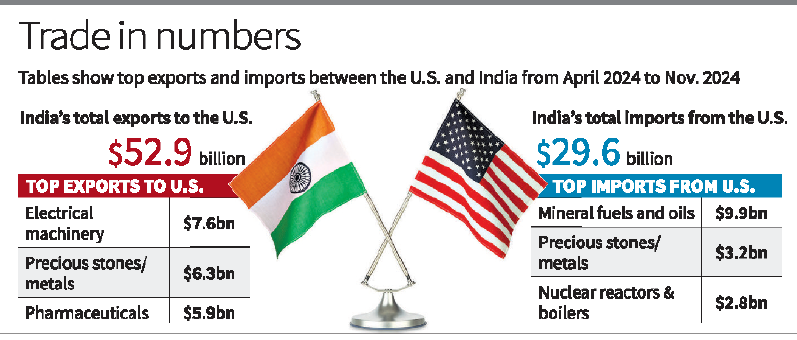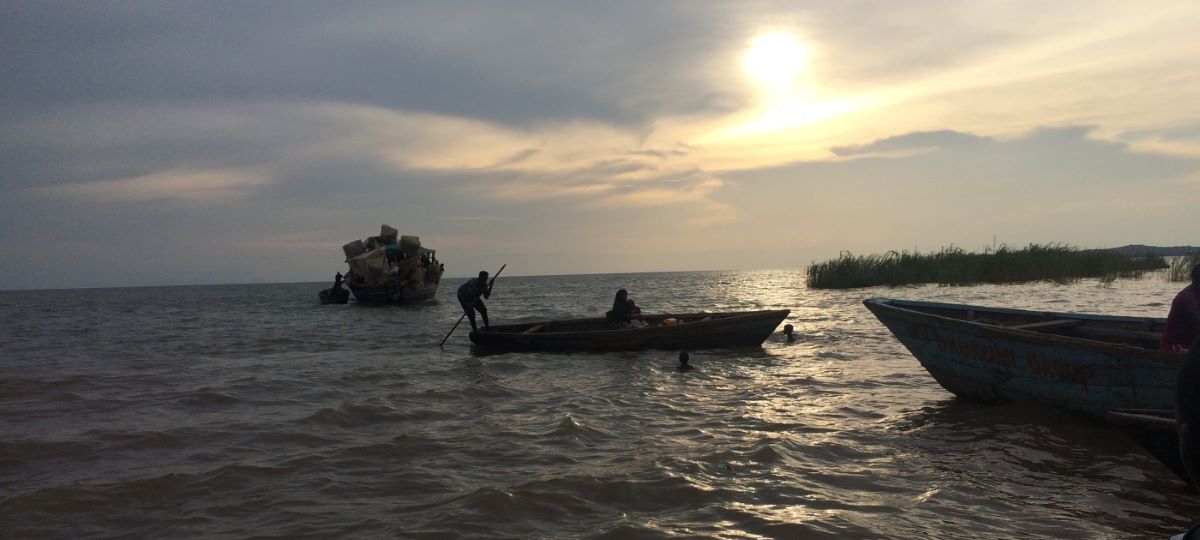U.S. Reciprocal Tariffs

- 09 Mar 2025
In News:
On April 2, 2025, the United States is set to implement reciprocal tariffs as announced by President Donald Trump during his address to a joint session of the U.S. Congress. The move targets major trade partners including India, China, the European Union, Canada, and Mexico.
What Are Reciprocal Tariffs?
- Definition: A reciprocal tariff is a trade measure in which a country imposes import duties equal to the tariffs its exports face in other nations.
- Objective: To establish a level playing field, correct trade imbalances, and respond to unfair tariff structures by trading partners.
- Application:
- If a foreign nation imposes high tariffs on U.S. goods, the U.S. will match that rate on goods imported from that country.
- Applies to goods, services, and even non-tariff barriers limiting U.S. market access.
Why Now? Trump’s Trade Strategy
- President Trump cited India’s high tariffs on automobile imports (reportedly over 100%) as an example of unfair trade.
- The U.S. also flagged China, EU, Brazil, and Mexico for imposing higher duties on U.S. exports.
- Trump emphasized that the U.S. has been “taken advantage of for too long” and that reciprocal tariffs are necessary to protect American jobs and industry.
WTO Implications
- May violate WTO's Most-Favoured-Nation (MFN) rule, which mandates equal treatment of trade partners.
- The U.S. could invoke Article XX (general exceptions) or Article XXI (national security exception) of the WTO Agreement to justify its policy.
Potential Impacts of Reciprocal Tariffs
Positive Impacts Negative Impacts
Boosts U.S. manufacturing by reducing import dependency May trigger retaliatory tariffs,
escalating trade wars
Encourages tariff reductions by partner nations Leads to higher import prices and
consumer inflation
Aims to reduce the trade deficit Causes economic uncertainty
and hurts investor confidence
Promotes domestic job creation May lead to WTO disputes and
strain diplomatic relations
PUNCH Mission

- 09 Mar 2025
In News:
NASA is set to launch the PUNCH (Polarimeter to Unify the Corona and Heliosphere) mission on March 6, 2025, from Vandenberg Space Force Base, California. It will be the third major solar mission launched globally in the past 18 months.
About the PUNCH Mission:
Aspect Details
Agency NASA (National Aeronautics and Space Administration)
Launch Date March 6, 2025
Mission Objective Study the Sun’s corona (outer atmosphere) and how solar wind evolves as it moves
into the heliosphere
Unique Features - First dedicated mission to image the transition from the corona to the heliosphere
- Will use four identical suitcase-sized satellites for continuous imaging of the inner corona
Importance - Improves understanding of space weather
- Helps predict solar storms, safeguarding satellites, astronauts, and
communication networks
What is the Solar Cycle?
- The solar cycle is an ~11-year periodic change in the Sun’s magnetic field, where the north and south poles flip positions.
- This cycle governs the level of solar activity, including sunspots, solar flares, and coronal mass ejections (CMEs).
- Solar Maximum: Period of peak activity with increased sunspots and solar eruptions.
- Solar Minimum: Period of least activity.
The current solar cycle began gaining momentum around May 2022, and solar activity remained above normal through 2024. The solar maximum is anticipated around 2025, offering an ideal window for solar observation.
Why the Surge in Solar Missions?
- Solar maximum periods offer the best conditions to observe high-energy events like flares and CMEs.
- Scientists aim to maximize data collection before the next solar minimum (next solar max expected ~2035–36).
- Monitoring solar activity is crucial because solar storms can disrupt satellite communications, navigation systems, and power grids on Earth.
Recent Major Solar Missions (2023–25):
Mission Agency Launch Date Purpose
Aditya-L1 ISRO (India) Sept 2, 2023 India’s first solar observatory; studies solar flares, solar winds, and magnetic fields
Proba-3 ESA (Europe) Dec 4, 2024 Dual-satellite mission to study solar corona and space weather
PUNCH NASA (USA) Mar 6, 2025 First mission to study continuous evolution from solar corona to heliosphere
Lake Tanganyika

- 09 Mar 2025
In News:
- The countries bordering Lake Tanganyika—Burundi, Democratic Republic of Congo (DRC), Tanzania, and Zambia—have launched a five-year biodiversity conservation project.
- The initiative, led by the United Nations Environment Programme (UNEP) and funded by the Global Environment Facility (GEF), aims to tackle transboundary threats to the lake’s biodiversity.
About Lake Tanganyika:
Feature Details
Location East Africa
Bordering Countries Burundi, DRC, Tanzania, Zambia
Length Over 400 miles (Longest freshwater lake in the world by length)
Depth One of the world’s deepest lakes
Geological Setting Located in the Western Rift Valley
Major Inflows Malagarasi, Ruzizi, Kalambo Rivers
Outflow Lukuga River (into the Lualaba River)
Flora Located at the floral transition zone of eastern and western Africa; oil palms found along shores
Livelihood Agriculture (rice, subsistence crops) and fishing are common
Key Features of the Conservation Project:
- Project Title:Biodiversity Conservation, Sustainable Land Management and Enhanced Water Security in Lake Tanganyika Basin
- Budget: USD 14.5 million
- Implementing Agency: UNOPS
- Strategic Partner: Lake Tanganyika Authority
- Framework Basis: Convention on the Sustainable Management of Lake Tanganyika (2003)
Project Objectives:
- Transboundary Cooperation: Foster collaboration among the four bordering nations
- Sustainable Fisheries: Establish fishing standards, including gear type, mesh sizes, and quotas
- Critical Habitat Protection: Secure core conservation zones in three protected areas and ensure sustainable use in buffer zones
- Community Involvement: Promote local participation in fisheries management and livelihood alternatives
- Land Restoration: Rehabilitate degraded landscapes and reduce environmental stressors
- Biodiversity Protection: Align with the Kunming-Montreal Global Biodiversity Framework goals
Why It Matters:
- Biodiversity Hotspot: The basin supports over 10 million people and is home to rich and unique freshwater biodiversity
- Threats: Habitat destruction, overfishing, pollution, invasive species, climate change, and uncoordinated lake management
- Alarming Trend: Global freshwater biodiversity has declined by 84% in the last century, faster than terrestrial or marine biomes
- Economic Risk: The global value of lake ecosystem services (~USD 3 trillion) could drop by 20% by 2050 if degradation continues
Marbled Cat
- 09 Mar 2025
In News:
- Rare marbled cats (Pardofelis marmorata) were recently captured on camera traps in DehingPatkai National Park, located in Assam's Tinsukia district.
- This was part of a two-month biodiversity monitoring initiative launched in November 2024 by the Assam Forest Department in collaboration with the Wildlife Institute of India (WII).
Significance of the Sighting:
- 2–3 individuals were recorded, marking a significant discovery for biodiversity documentation in Northeast India.
- Assam's Forest Minister and conservationists hailed the event as a testament to successful conservation efforts and the rich biodiversity of DehingPatkai.
About the Marbled Cat:
- Scientific Name: Pardofelis marmorata
- IUCN Status: Near Threatened (NT)
- Habitat: Dense tropical and subtropical forests; found at elevations up to 2,500 metres
- Distribution:
- Countries: India, Nepal, Bhutan, Bangladesh, Myanmar, Thailand, Laos
- In India: Found primarily in Arunachal Pradesh, Assam, Meghalaya, and Nagaland
Physical Features:
- Small wild cat with distinctive marbled-patterned fur (brown/grey with black stripes and spots)
- Excellent arboreal climber, capable of leaping between trees
- Males weigh 4.5–9 kg; females weigh 2.5–5 kg
- Solitary and territorial; marks territory with scent
Conservation Implications:
- The sighting underscores the ecological value of DehingPatkai, a critical habitat for many rare and threatened species.
- Experts stress the need for continued research, habitat preservation, and protection of Eastern Himalayan forests to ensure the survival of elusive species like the marbled cat.
Cities Coalition for Circularity (C-3)

- 09 Mar 2025
In News:
Manohar Lal, Union Minister for Housing and Urban Affairs, announced the Cities Coalition for Circularity (C-3), a multi-nation alliance for city-to-city collaboration, knowledge-sharing, and private sector partnerships.
- Platform: 12th Regional 3R and Circular Economy Forum in Asia and the Pacific
- Venue: Rajasthan International Centre, Jaipur, Rajasthan
What is C-3?
- The Cities Coalition for Circularity (C-3) is a multi-national alliance aimed at enhancing city-to-city collaboration, knowledge-sharing, and public-private partnerships.
- It focuses on promoting circular economy principles, resource efficiency, and low-carbon development.
Organizers and Supporters:
- Organized by: Ministry of Housing and Urban Affairs (India), United Nations Centre for Regional Development (UNCRD), and Institute for Global Environmental Strategies (IGES)
- Supported by: United Nations ESCAP, Ministry of Environment (Japan), and other global organizations
Key Announcements:
- Formation of a Working Group to finalize the coalition’s structure and operational framework
- Adoption of the Jaipur Declaration (2025–2034) – a nonpolitical, nonbinding declaration guiding the next decade of action for resource-efficient and sustainable urban growth
Highlights of the Forum:
- Theme: Realizing Circular Societies Towards Achieving SDGs and Carbon Neutrality in Asia-Pacific
- 3R India Pavilion: Inaugurated by Union Minister and Rajasthan CM Bhajanlal Sharma, showcasing 40+ Indian and Japanese start-ups in waste management and circular solutions
What is a Circular Economy?
A circular economy is a regenerative system where:
- Products, materials, and resources are maintained in use for as long as possible
- Waste is minimized through reuse, recycling, remanufacturing, composting, etc.
- It aims to decouple economic growth from resource consumption, addressing climate change, pollution, and biodiversity loss.
